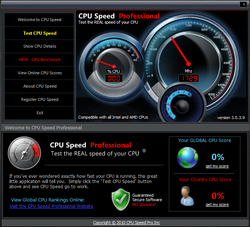THE FUTURE OF PORTABLE TECHNOLOGY
Speed

Process speed has an important factor of what make up a pc and even more important when it comes portable technology. Applications and daily essentials will require more speed to than it take nowadays to play full 3D games.
There different main types of speed: CPU speed, Motherboard Speed, Memory Speed, Graphic Speed, and Hard Drive Speed.
CPU-Central Process Unit is major speed that portable technology is made up from. A 2mm by 2.1mm chipset can power up the whole computer run intense applications, play HD games, be stress tested over weeks all within a small but mighty chipset. By 2020, CPU will have the ability of not limited to beating Albert Einstein in his own theories; solve impossible calculations in milliseconds and playing theatre quality movies. CPU today have reached speeds of which will be double every annual. CPU in 2020 will have major uprising speed in the future.
The board which the CPU is slotted to is called the motherboard or mainboard. The motherboard bottlenecks the speed of the computer to 6.4 GB/s today. Motherboards will be made of laser fibre optics provide the near matched speed of light. Compared to the National Broadband Network using fibre optics, the speed is almost to the power of six. This will be the standard speed of every phone in the world. Overclocking will never be that hard.
Speeds of the memory are dependent on the motherboard, CPU, and Northbridge and Southbridge chipsets. As the speed of the operating system run is the speed your memory or RAM run. Today high performance memory sticks run at 3 000 MHz but in the nearby future memory will at 128 000 MHz, 41 times the speed of today. By 2020, phone memory can anticipate full holographic HD games will lag or jitter, edit Blu-ray movies without waiting few hours to load and high quality video chats.
Graphic speed has been the decider for high quality video games. The amount of pixels or dot on your screen is the quality of your screen. Full HD screens have 2 073 600 pixels, while 2048p have 5 242 880 pixels which is 2.5 times as clear as full HD. Graphics card will need to have a processing speed of 64GB/s to play 2048p videos. For holographic videos, the pixels need to be to the power of three. That speed is enough to power fifteen theatres at once. Imagine that all be fit into one single chipset, of futuristic phone and laptop.
The speed of transferring data across multiple computers all depend on the hard drive speed. Fibre optics will replace will replace all mainboards inside the HDD. Because the speed of light is the same with laser, the delay will be the same to get information from one place to another. When data is copied, the speed is almost instant.
The speed of all these combined will create a supercomputer not in size but in speed. All of this will fit under on microscopic wafer made by nanotech.
There different main types of speed: CPU speed, Motherboard Speed, Memory Speed, Graphic Speed, and Hard Drive Speed.
CPU-Central Process Unit is major speed that portable technology is made up from. A 2mm by 2.1mm chipset can power up the whole computer run intense applications, play HD games, be stress tested over weeks all within a small but mighty chipset. By 2020, CPU will have the ability of not limited to beating Albert Einstein in his own theories; solve impossible calculations in milliseconds and playing theatre quality movies. CPU today have reached speeds of which will be double every annual. CPU in 2020 will have major uprising speed in the future.
The board which the CPU is slotted to is called the motherboard or mainboard. The motherboard bottlenecks the speed of the computer to 6.4 GB/s today. Motherboards will be made of laser fibre optics provide the near matched speed of light. Compared to the National Broadband Network using fibre optics, the speed is almost to the power of six. This will be the standard speed of every phone in the world. Overclocking will never be that hard.
Speeds of the memory are dependent on the motherboard, CPU, and Northbridge and Southbridge chipsets. As the speed of the operating system run is the speed your memory or RAM run. Today high performance memory sticks run at 3 000 MHz but in the nearby future memory will at 128 000 MHz, 41 times the speed of today. By 2020, phone memory can anticipate full holographic HD games will lag or jitter, edit Blu-ray movies without waiting few hours to load and high quality video chats.
Graphic speed has been the decider for high quality video games. The amount of pixels or dot on your screen is the quality of your screen. Full HD screens have 2 073 600 pixels, while 2048p have 5 242 880 pixels which is 2.5 times as clear as full HD. Graphics card will need to have a processing speed of 64GB/s to play 2048p videos. For holographic videos, the pixels need to be to the power of three. That speed is enough to power fifteen theatres at once. Imagine that all be fit into one single chipset, of futuristic phone and laptop.
The speed of transferring data across multiple computers all depend on the hard drive speed. Fibre optics will replace will replace all mainboards inside the HDD. Because the speed of light is the same with laser, the delay will be the same to get information from one place to another. When data is copied, the speed is almost instant.
The speed of all these combined will create a supercomputer not in size but in speed. All of this will fit under on microscopic wafer made by nanotech.
